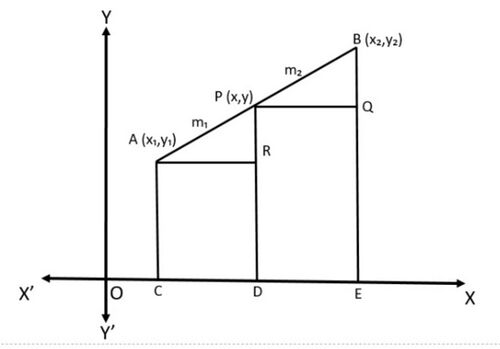|
|
| (One intermediate revision by the same user not shown) |
| Line 1: |
Line 1: |
| The Section formula is used to find the coordinates of the point that divides a line segment (externally or internally) into some ratio.
| | विभाजन-सूत्र का उपयोग उस बिंदु के निर्देशांक ज्ञात करने के लिए किया जाता है जो किसी रेखाखंड को (बाह्य या आंतरिक रूप से) किसी अनुपात में विभाजित करता है। |
|
| |
|
| == Derivation of Section Formula == | | == विभाजन-सूत्र की व्युत्पत्ति == |
| [[File:Section Formula.jpg|alt=Fig 1 - Section Formula|none|thumb|500x500px|Fig 1 - Section Formula]] | | [[File:Section Formula.jpg|alt=Fig 1 - Section Formula|none|thumb|500x500px|चित्र -1 -विभाजन-सूत्र]] |
| Consider any two points <math>A(x_1,y_1)</math> and <math>B(x_2,y_2)</math> and assume that <math>P(x,y)</math> divides <math>AB</math> internally in the ratio <math>m_1:m_2</math> ,
| | किन्हीं दो बिंदुओं <math>A(x_1,y_1)</math> और <math>B(x_2,y_2)</math> पर विचार करें और मान लीजिये <math>P(x,y)</math>, <math>AB</math> को आंतरिक रूप से अनुपात <math>m_1:m_2</math> में विभाजित करता है। |
|
| |
|
| i.e., <math>\frac{PA}{PB}=\frac{m_1}{m_2}</math> (see Fig. 1).
| | अर्थात <math>\frac{PA}{PB}=\frac{m_1}{m_2}</math> (चित्र 1 देखें) |
|
| |
|
| Draw <math>AC,PD,BE</math> perpendicular to the <math>x-</math>axis. Draw <math>AR,PQ</math> parallel to the <math>x-</math>axis. Then, by the <math>AA</math> similarity criterion,
| | <math>x-</math>अक्ष पर लंबवत <math>AC,PD,BE</math> खींचें। <math>x-</math>अक्ष के समानांतर <math>AR,PQ</math> खींचें। फिर, <math>AA</math> समानता मानदंड से, |
|
| |
|
| <math>\bigtriangleup PAR\sim \bigtriangleup BPQ</math> | | <math>\bigtriangleup PAR\sim \bigtriangleup BPQ</math> |
| Line 21: |
Line 21: |
| <math>BQ=BE-QE=BE-PD=y_2-y</math> | | <math>BQ=BE-QE=BE-PD=y_2-y</math> |
|
| |
|
| Substituting in <math> (1)</math> we get
| | <math> (1)</math> प्रतिस्थापित करने पर हमें प्राप्त होता है |
|
| |
|
| <math>\frac{m_1}{m_2}=\frac{x-x_1}{x_2-x}=\frac{y-y_1}{y_2-y}</math> | | <math>\frac{m_1}{m_2}=\frac{x-x_1}{x_2-x}=\frac{y-y_1}{y_2-y}</math> |
|
| |
|
| | | |
| | | <math>\frac{m_1}{m_2}=\frac{x-x_1}{x_2-x}</math> लेने पर |
| Taking <math>\frac{m_1}{m_2}=\frac{x-x_1}{x_2-x}</math>
| |
|
| |
|
| <math>m_1x_2-m_1x=m_2x-m_2x_1</math> | | <math>m_1x_2-m_1x=m_2x-m_2x_1</math> |
| Line 39: |
Line 38: |
|
| |
|
|
| |
|
| Taking <math>\frac{m_1}{m_2}=\frac{y-y_1}{y_2-y}</math>
| | |
| | <math>\frac{m_1}{m_2}=\frac{y-y_1}{y_2-y}</math> लेने पर |
|
| |
|
| <math>m_1y_2-m_1y=m_2y-m_2y_1</math> | | <math>m_1y_2-m_1y=m_2y-m_2y_1</math> |
| Line 49: |
Line 49: |
| <math>y=\frac{m_1y_2+m_2y_1}{m_1+m_2}</math> | | <math>y=\frac{m_1y_2+m_2y_1}{m_1+m_2}</math> |
|
| |
|
| So, the coordinates of the point <math>P(x,y)</math> which divides the line segment joining the points <math>A(x_1,y_1)</math> and <math>B(x_2,y_2)</math>, internally, in the ratio <math>m_1:m_2</math> are <math>\left (\frac{m_1x_2+m_2x_1}{m_1+m_2},\frac{m_1y_2+m_2y_1}{m_1+m_2} \right )</math> is the section formula.
| | इसलिए, बिंदु <math>P(x,y)</math> के निर्देशांक जो बिंदु <math>A(x_1,y_1)</math> और <math>B(x_2,y_2)</math> को मिलाने वाले रेखाखंड को आंतरिक रूप से किस अनुपात में विभाजित करते हैं |
| | |
| | <math>m_1:m_2</math> are <math>\left (\frac{m_1x_2+m_2x_1}{m_1+m_2},\frac{m_1y_2+m_2y_1}{m_1+m_2} \right )</math> विभाजन-सूत्र है। |
|
| |
|
| === Example === | | === उदाहरण === |
| Find the coordinates of the point which divides the line segment joining the points <math>(4,-3)</math> and <math>(8,5)</math> in the ratio <math>3:1</math> internally.
| | उस बिंदु के निर्देशांक ज्ञात करें जो बिंदुओं <math>(4,-3)</math> और <math>(8,5) |
| | </math> को मिलाने वाले रेखाखंड को <math>3:1</math> के अनुपात में आंतरिक रूप से विभाजित करता है। |
|
| |
|
| '''Solution''' : Let <math>P(x,y)</math> be the required point. | | '''हल''' : <math>P(x,y)</math> को वांछित बिंदु मान लें। |
|
| |
|
| <math>x_1=4,y_1=-3</math> | | <math>x_1=4,y_1=-3</math> |
|
| |
|
| <math>x_2=8,y_2=5</math> | | <math>x_2=8,y_2=5</math> |
| Line 63: |
Line 66: |
|
| |
|
|
| |
|
| Using the section formula, we get
| | विभाजन-सूत्र का उपयोग करते हुए, हम प्राप्त करते |
|
| |
|
| <math>x=\frac{m_1x_2+m_2x_1}{m_1+m_2}</math> | | <math>x=\frac{m_1x_2+m_2x_1}{m_1+m_2}</math> |
| Line 75: |
Line 78: |
|
| |
|
|
| |
|
| Therefore <math>(7,3)</math> is the required point.
| | अतः <math>(7,3)</math> ही अभीष्ट बिंदु है। |
|
| |
|
| [[Category:निर्देशांक ज्यामिति]][[Category:गणित]][[Category:कक्षा-10]] | | [[Category:निर्देशांक ज्यामिति]][[Category:गणित]][[Category:कक्षा-10]] |
विभाजन-सूत्र का उपयोग उस बिंदु के निर्देशांक ज्ञात करने के लिए किया जाता है जो किसी रेखाखंड को (बाह्य या आंतरिक रूप से) किसी अनुपात में विभाजित करता है।
विभाजन-सूत्र की व्युत्पत्ति
किन्हीं दो बिंदुओं  और
और  पर विचार करें और मान लीजिये
पर विचार करें और मान लीजिये  ,
,  को आंतरिक रूप से अनुपात
को आंतरिक रूप से अनुपात  में विभाजित करता है।
में विभाजित करता है।
अर्थात  (चित्र 1 देखें)
(चित्र 1 देखें)
 अक्ष पर लंबवत
अक्ष पर लंबवत  खींचें।
खींचें।  अक्ष के समानांतर
अक्ष के समानांतर  खींचें। फिर,
खींचें। फिर,  समानता मानदंड से,
समानता मानदंड से,






 प्रतिस्थापित करने पर हमें प्राप्त होता है
प्रतिस्थापित करने पर हमें प्राप्त होता है

 लेने पर
लेने पर




 लेने पर
लेने पर




इसलिए, बिंदु  के निर्देशांक जो बिंदु
के निर्देशांक जो बिंदु  और
और  को मिलाने वाले रेखाखंड को आंतरिक रूप से किस अनुपात में विभाजित करते हैं
को मिलाने वाले रेखाखंड को आंतरिक रूप से किस अनुपात में विभाजित करते हैं
 are
are  विभाजन-सूत्र है।
विभाजन-सूत्र है।
उदाहरण
उस बिंदु के निर्देशांक ज्ञात करें जो बिंदुओं  और
और  को मिलाने वाले रेखाखंड को
को मिलाने वाले रेखाखंड को  के अनुपात में आंतरिक रूप से विभाजित करता है।
के अनुपात में आंतरिक रूप से विभाजित करता है।
हल :  को वांछित बिंदु मान लें।
को वांछित बिंदु मान लें।



विभाजन-सूत्र का उपयोग करते हुए, हम प्राप्त करते




अतः  ही अभीष्ट बिंदु है।
ही अभीष्ट बिंदु है।
